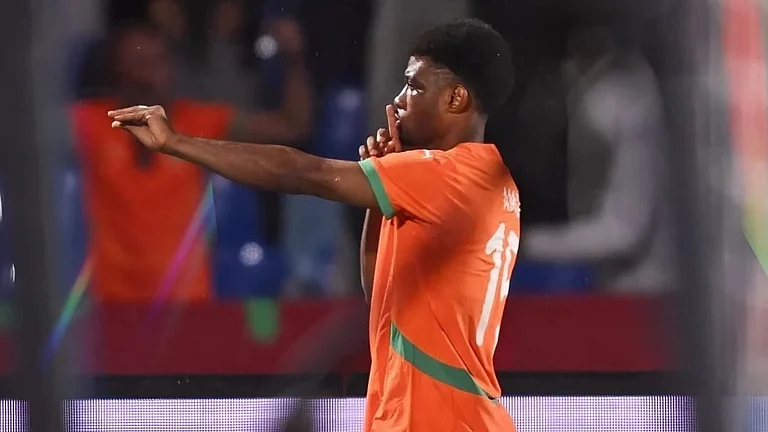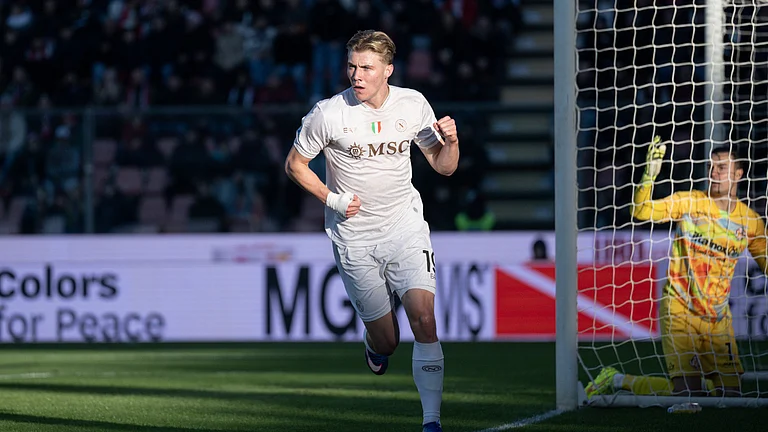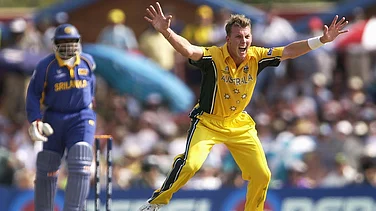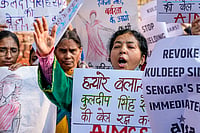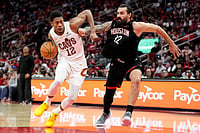This weekend it would be known if Sunil Chhetri’s Bengaluru Football Club makes history, or breaks hearts, in Doha when it faces the tough Iraqi team Al-Quwa Al-Jawiya in the Asian Football Confederation (AFC) final. But whatever the outcome, the fact that an Indian club is in the final of the AFC has disrupted many sports fans’ worship at the altar of cricket, forcing them to cast a surprised, sideways glance at the world’s favourite game. Last month, India touched 137th at the FIFA rankings—the goalpost may be far yet, but it is our best position ever.
So, is the ‘beautiful game’ luring fans in India beyond its pocket boroughs in Goa, Kerala, the Northeast and Bengal? It’s on the rise, says Chhetri,32, also captain of the Indian team. He feels the stirrings of a footballing revolution, though he treads cautiously. “There’s a steady surge in the country with relation to football’s popularity and it’s on its way to snowballing into something big,” Chhetri tells Outlook. “Whether it will get as big or more popular than cricket is anybody’s guess but the signs are all there.”
Chhetri scored a brace in Bengaluru FC’s 3-1 win over defending champions Johor Darul Ta’zim of Malaysia in the semi-final second-leg match in Bangalore, which got his team trending. “Bengaluru FC making the final of the AFC Cup generated an unbelievable amount of buzz, one like I haven’t seen before. It just goes to show when the sport is run correctly, success will follow and, in turn, attention,” says the talismanic striker.
Indian football has been snagging attention through the Indian Super League (ISL). Now into its third season, ISL is a hit on TV and inside stadiums, leaving the I-League, the nine-year-old official league, behind both in terms of quality and popularity. Add to that an unending stream of the world’s top leagues, featuring the game’s global stars, on sports television. A Barca No 10 Messi shirt is just as cool among urban youth as Kohli’s India blue.
But can football ever compete with the national opiate, cricket? Since the ’80s, India’s national game, hockey, has been in steady, then steep, decline, leading to a concomitant lack of interest amongst youth and a fraying of the sentimental hold it had in Indian hearts. However, there has been a relative resurgence in its fortunes in the past two years, leading to successes like the Asian Champions Trophy title this week. Football has emerged as the closest challenger to cricket in terms of popularity among the young.

Kohli, Dhoni at the Celebrity Clasico charity match in Mumbai
An icon in Indian football and former India captain Subimal ‘Chuni’ Goswami also feels the standard of football is on the upward swing. If hosts India perform well in next year’s FIFA under-17 World Cup, it would be a “definite game changer”, says Kushal Das, secretary-general of the All India Football Federation (AIFF). “The Bangalore crowd in the AFC Cup semi-final shows football is still popular, and if you dish out good football they are keen to come and watch,” says Chuni,78, who captained India to gold at the 1962 Asian Games. “Football has been very popular, but people are not keen on attending as our national team’s performance has not been good. But the crowd in Bangalore indicated its enduring popularity,” he points out. Utpal Ganguly, secretary of the Indian Football Association (IFA), the parent body in Bengal, also says football had always had “people’s support”.
“Cricket has been a more visible sport; TV and sponsor support in cricket has been more. And, undeniably, the Indian cricket team has tasted more success. But there’s a swing towards football in terms of visibility. And if India performs reasonably well in the under-17 World Cup it’ll be a benchmark for a turnaround,” he says. Syed Shahid Hakim, an Olympian and FIFA referee, says football was always the people’s choice in the past. “Football was the most popular game till the ’80s; rather, it is the most popular even today in terms of people playing it. A game of football anywhere attracts 200-300 people. In the last 25 years or so its popularity went down a bit,” says Hakim.
Former India coach and player Sukhvinder Singh differs slightly. “When I was playing, there was not much of a difference in the popularity of football and cricket. But cricket has gone much ahead. Still, no one should ignore the craze for football. And to regain its popularity is not a difficult task,” says the 67-year-old former India stopper back. He says it’s too early to predict football toppling cricket in popularity. A gung-ho Kushal Das begs to differ. He says the launch of the ISL in 2014 has brought in the “necessary visibility and excitement” in Indian football. He emphasises that the AIFF is now looking to “consolidate the professional club game” to make it “sustainable and spread its footprint” across India. “That three-year-old Bengaluru FC has made history by being the first Indian club to play in the AFC Cup finals is an INSpiration to other clubs,” he says.

Ranbir Kapoor at an exhibition match in New Delhi
Shaji Prabhakaran, FIFA development officer for South and Central Asia, points to a definite shift in mind-set of the school-going kids. “Encouragingly, today’s young generation is following more football than cricket, especially in urban and tier-II cities. A survey in any urban school, especially in Delhi, Mumbai or Bangalore will find that seven students out of 10 are madly into football. Cricket is nowhere in the picture in that age group,” he says. “People aged 35 and above are still into cricket while people below 25 are football fanatics.” Television viewership of football, mostly comprising foreign leagues like the English Premier League and La Liga, has helped in the proliferation of fans. “By far, football is easily the largest played sport in the country. Urban areas, rural areas and metro cities, anywhere you go football is the cheapest sport, and it is already popular in schools. With access to all top leagues of the world and fantasy play station for kids, football viewership has soared,” says Srinivas Murthy, head of operations, Bengaluru FC.
Apparently, FIFA is closely monitoring developments in India, and is betting on the game becoming big. A pan-India survey it conducted this year among school students shows that kids attend more football events than cricket. But it stops there. “Maybe technically, the transition from the school to the professional level is not happening; there’s a gap. There’s a gap for a kid who has taken up football at a young age and wants to transform himself into a professional player,” says Murthy.
There is a move by the AIFF to merge the ISL and I-League from next year, and many people feel it would help football attract more fans, as loyalties won’t be divided. “This way, people’s interest will not be diverted or scattered. We should rejuvenate one league in India,” says Chuni Goswami. Agrees Sukhvinder. “I-League has lost its glamour. ISL has helped create a new ground for football’s popularity. So, if I-League and ISL move ahead with a good understanding, Indian football will benefit,” he says. Utpal Ganguly feels the merger of the leagues would get more corporate support.
At the moment, eight teams compete in ISL and nine in I-League. Hakim says these numbers should be increased to give opportunities to more players. “ISL and I-League will take you nowhere. India is not England. Here, if 9,000 teams play, in a manner of speaking, only then can the country come up on the world map. Every state and city should have leagues.” Hakim makes another telling point, something that has been debated over the years: a glut of foreign forwards in club teams that hampers the creation of quality home-made strikers. “Every team in these two leagues have many foreigners. The question is: can you pick foreigners in the Indian team for the World Cup qualifiers?” he asks. Goals matter in football. They win matches. And India is often found wanting in this. That could be one reason for India qualifying for the World Cup only once, 66 years ago. That came after some teams had withdrawn, but it didn’t matter, as Indians insisted on playing barefoot, but FIFA expressly forbade that. The last time India made it to the Olympics was 56 years ago, and their best finish there was a fourth position finish in 1956.
What Indian football needs is a few Dhonis and Kohlis. “Cricket has had many international iconic players. Unfortunately, post Bhaichung Bhutia—and except Sunil Chhetri now—we haven’t got an iconic name in football,” says Ganguly. Ironically, some cricket icons are into the soccer business, with many part-owning ISL teams, like Sachin Tendulkar (Kerala Blasters), Sourav Ganguly (Atletico de Kolkata), M.S. Dhoni (Chennaiyin FC) and Virat Kohli (FC Goa). “The investment opportunity in football is 20 per cent of what cricket offers. As soon as it goes up to 50 per cent, football would be massive in India. And by the time India establishes a strong league and achieves some international success, even at the youth level it’ll give a tough fight to cricket,” says Prabhakaran. “The day India qualifies for the FIFA World Cup, it will overthrow cricket in terms of popularity,” he adds. That day, every Indian football fan will be as eager as Messi to kick the ball in an elliptical angle, just above the jumping ‘wall’, just below the looming goal post.







